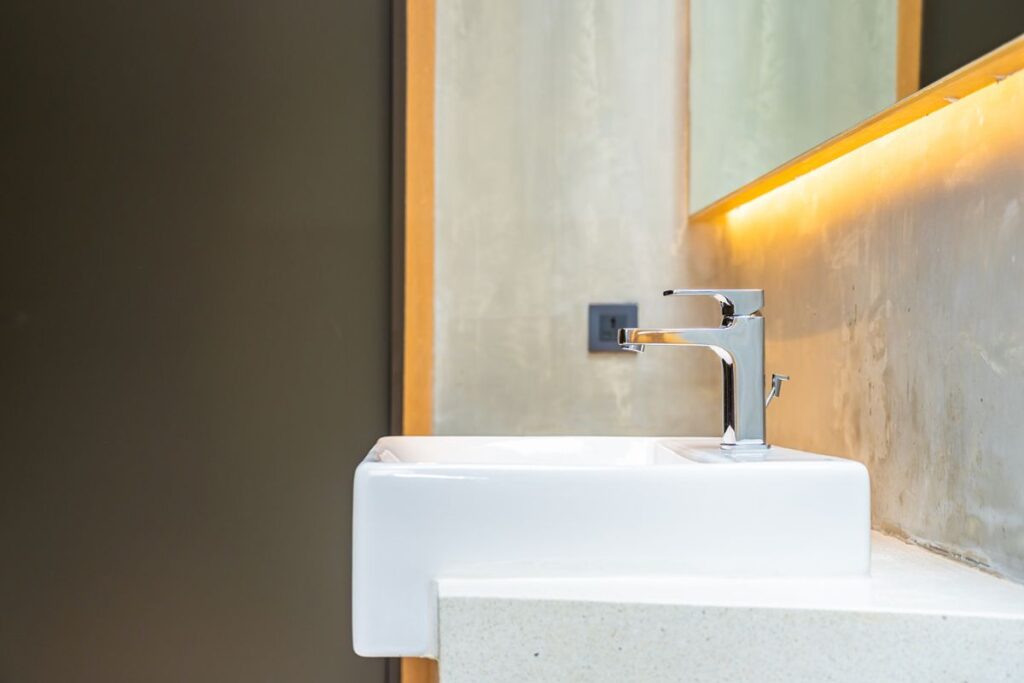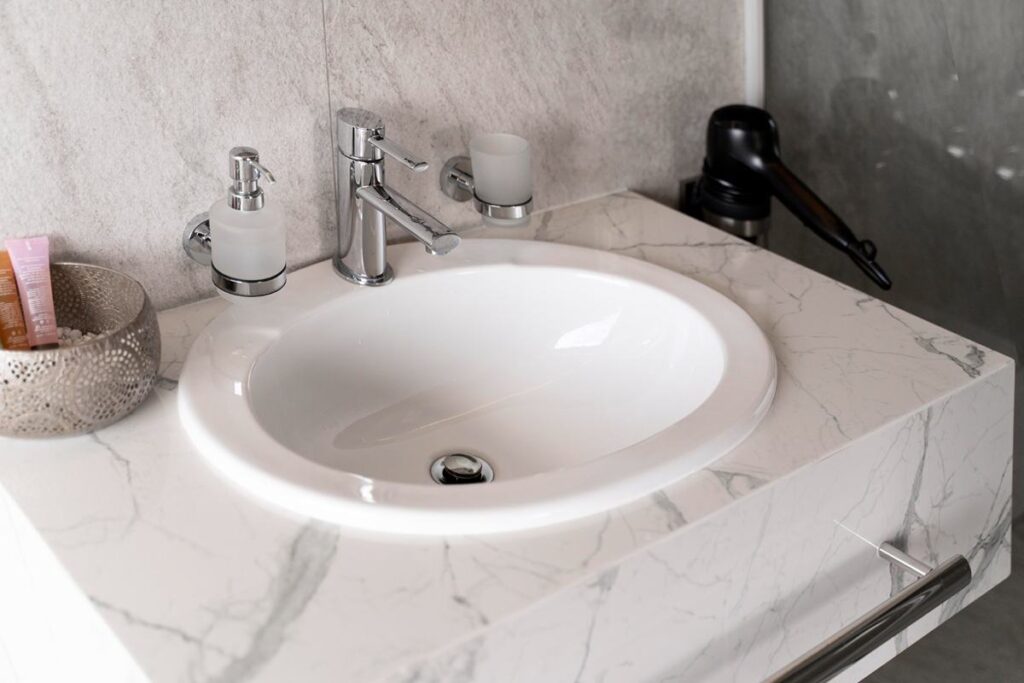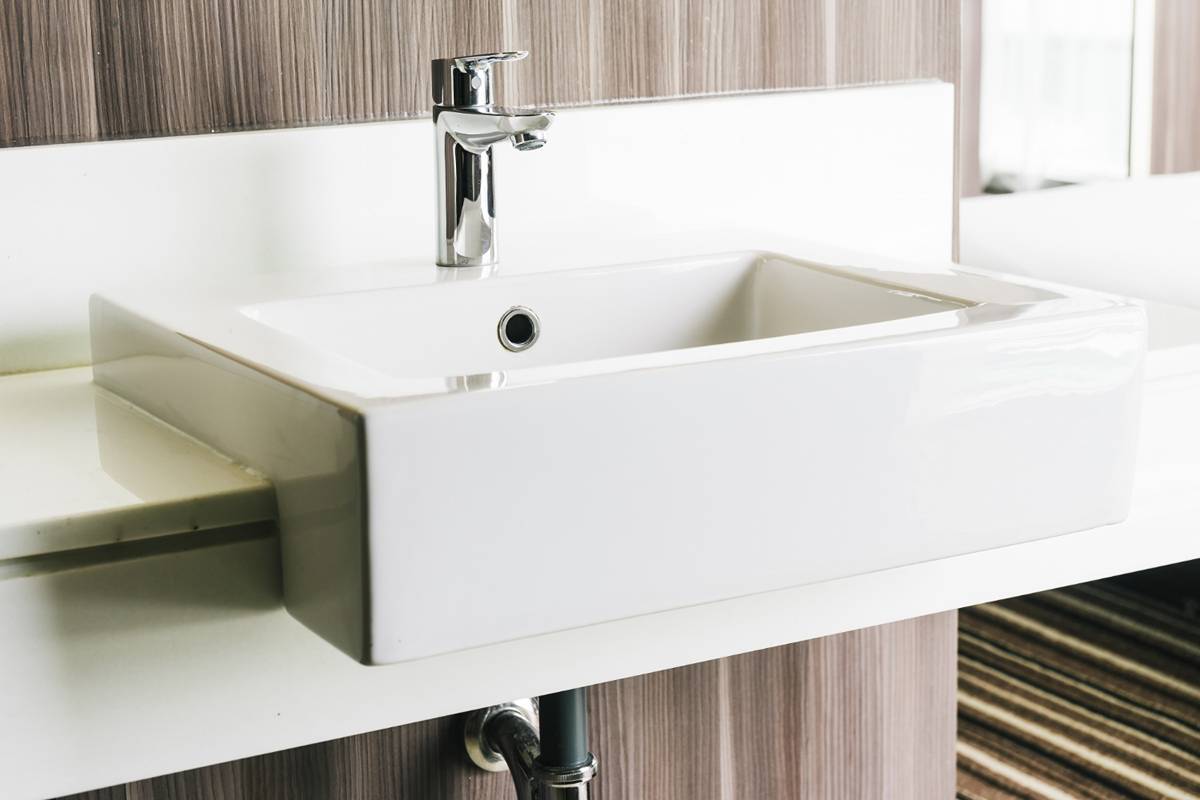An epoxy sink is a durable and versatile sink made from epoxy resin, offering superior strength and resistance to heat, chemicals, and stains. These sinks are becoming increasingly popular in a variety of settings, from laboratories to bathrooms and kitchens, due to their resilience and sleek, modern look. Whether you’re looking for a sink that can withstand harsh chemicals in a lab or one that complements a contemporary home design, an epoxy sink delivers both functionality and style. In this guide, we will explore the benefits of epoxy sinks, how to repair them, installation tips, and how to maintain them for long-lasting performance.
What Is an Epoxy Sink?
An epoxy sink is a type of sink made from epoxy resin, a tough and durable material. Epoxy resin is known for its exceptional resistance to heat, chemicals, and stains, making it the ideal choice for high-performance environments. These sinks have a non-porous surface, which prevents the absorption of liquids, helping to maintain a clean and hygienic surface. The durable material is also resistant to scratches and chips, ensuring long-term use even in high-traffic areas.
Made to Last: What It’s Made Of
Epoxy resin is a combination of a hardener and a resin that, when mixed, forms a solid and long-lasting surface. This material is specifically designed for environments where durability is crucial. The main benefits of epoxy resin include:
- Heat Resistance: Epoxy sinks can handle hot pots and pans, making them a perfect addition to kitchens and laboratories.
- Durability: Epoxy sinks are built to last, withstanding years of use without cracking or fading.
- Non-Porous Surface: The non-porous nature prevents stains and bacteria build-up, keeping your sink clean and sanitary.
Common Places Where Epoxy Sinks Are Used
Epoxy sinks are widely used in a variety of settings due to their durable and resilient nature. Some common places where epoxy sinks are installed include:
- Labs: Epoxy sinks are ideal for laboratories where chemical resistance is a must. They handle spills and accidents without damage.
- Hospitals: In medical settings, epoxy sinks are perfect for washing and sterilizing equipment due to their non-porous and easy-to-clean surface.
- Kitchens: Epoxy sinks are gaining popularity in modern kitchens for their ability to resist scratches, stains, and heat.
- Bathrooms: The sleek and stylish design of epoxy sinks makes them a popular choice for bathrooms, offering both functionality and a modern aesthetic.
Epoxy sinks come in various styles, including drop-in and undermount types. Drop-in sinks are placed on top of the countertop, while undermount sinks are installed beneath the countertop, offering a seamless look. Both styles provide the same benefits but offer different installation and aesthetic options based on your preference.
Why Choose an Epoxy Sink?
Choosing an epoxy sink offers several key benefits that make it a top choice for both home and commercial use. These sinks are designed to withstand the toughest conditions, providing long-lasting performance and exceptional durability. Here’s why you should consider an epoxy sink for your next installation or replacement:
Strong and Durable: Epoxy sinks are made to last for many years, withstanding daily wear and tear in high-use environments like kitchens, bathrooms, and laboratories.
Resists Heat, Chemicals, and Scratches: Whether you’re dealing with hot cookware, harsh chemicals, or sharp utensils, epoxy sinks hold up to the challenge without showing signs of damage or deterioration.
Long-Lasting in Both Home and Commercial Use: Whether in a home kitchen or a busy laboratory, epoxy sinks perform reliably over time, making them a great investment for both personal and professional spaces.
Easy to Clean, No Stains: The smooth, non-porous surface of an epoxy sink ensures that stains, dirt, and bacteria can’t penetrate. Cleaning is a breeze, keeping your sink looking fresh and hygienic with minimal effort.
Aesthetic Variety in Color & Finish: Epoxy sinks come in various colors and finishes, allowing you to choose one that complements your style, whether you prefer a modern, sleek look or a more classic appearance.
- Tough against chemicals – Ideal for labs and kitchens where harsh substances are used.
- Handles hot items – Perfect for withstanding hot pots, pans, and boiling water without damage.
- Low maintenance – Requires minimal care to maintain its clean and attractive surface.
- Smooth, stylish finish – Adds a touch of elegance and modern appeal to any space.
Bathroom Sink Epoxy for Repair

An epoxy sink repair kit is an excellent solution for fixing minor damage to your bathroom sink. Whether your sink has developed cracks, discoloration, or a dull appearance, epoxy can restore it to its original condition. Let’s explore when it’s time to repair your bathroom sink and how to use an epoxy repair kit effectively.
When Does Your Sink Need Repair?
It’s important to know when to repair your bathroom sink, as small damages can worsen over time if not addressed. Look out for these signs that your sink might need repair:
- Cracks: Small cracks can appear due to daily use or exposure to extreme temperature changes.
- Discoloration: Over time, sinks can become stained or faded, especially with constant exposure to water, soap, and cleaning products.
- Dullness: A once shiny surface may lose its luster due to wear, making your sink look older and worn.
How to Use Epoxy Sink Repair Kit
Using an epoxy sink repair kit is a simple process that you can do yourself. Follow these steps to effectively repair your bathroom sink:
- Clean the Damaged Area: Start by thoroughly cleaning the damaged area of your sink. Remove any dirt, soap residue, and moisture to ensure the epoxy adheres properly to the surface.
- Mix and Apply the Epoxy Sink Repair Kit: Most epoxy repair kits come with two parts: resin and hardener. Mix them according to the instructions provided in the kit. Once mixed, apply the epoxy mixture to the damaged area, filling in cracks or covering discoloration.
- Let It Dry and Sand Smoothly: Allow the epoxy to dry completely as per the manufacturer’s instructions. Once it’s dry, use fine-grit sandpaper to smooth the surface and make it blend seamlessly with the rest of the sink. This will leave your sink looking as good as new.
Epoxy Sink Paint – Can You Change the Look?
One of the most appealing aspects of an epoxy sink is its ability to withstand wear and tear, but did you know you can also change the look of your sink? If your epoxy sink is starting to look dull or if you simply want to update its style, you can repaint it with the right materials. However, there are some important things to consider to ensure the new coat of paint lasts.
Can You Repaint an Epoxy Sink?
Yes, you can repaint an epoxy sink! However, it’s important to use the right type of paint to ensure a smooth finish and long-lasting results. Regular paints can’t handle the demands of an epoxy sink, as they may peel or chip over time due to the sink’s constant exposure to water and cleaning products. Instead, you must use epoxy-safe paint specifically designed for high-durability surfaces like epoxy sinks.
Types of Paint Used (Epoxy-Safe Paint Only)
To ensure the best results when repainting your epoxy sink, only use epoxy-safe paint. These paints are designed to bond well with the resin surface, offering the strength needed to resist moisture, heat, and chemicals. Some common types of epoxy-safe paints include:
- Two-Part Epoxy Paint: This type is mixed with a hardener and provides a durable, long-lasting finish perfect for sinks.
- Acrylic Epoxy Paint: A slightly more flexible option that still offers a good level of durability for sink surfaces.
Simple Instructions on How to Paint and Seal
Repainting your epoxy sink can be an easy and rewarding DIY project if you follow these simple steps:
- Clean the Sink Thoroughly: Before you begin, make sure the sink is clean and dry. Remove any soap scum, stains, or residue by scrubbing the sink with a non-abrasive cleaner.
- Sand the Surface: Lightly sand the surface of the sink to create a rough texture. This will help the paint adhere better. Use fine-grit sandpaper to avoid damaging the epoxy surface.
- Apply the Paint: Follow the manufacturer’s instructions on your epoxy-safe paint. Apply thin, even coats of paint, allowing each layer to dry completely before applying the next.
- Seal the Surface: After the final coat of paint has dried, apply an epoxy clear sealer to protect the finish. This will enhance durability and help the new paint last longer.
Warnings: Don’t Use Regular Paint
It’s crucial not to use regular household paint on your epoxy sink. Standard paints can’t handle the moisture and chemicals that an epoxy sink is exposed to. They will likely peel, chip, or fade over time, leading to an unsightly and short-lived finish. Always opt for epoxy-safe paint to ensure the best results and long-lasting protection for your sink.
Epoxy Sink to Countertop Connection
One of the best features of an epoxy sink is its ability to integrate seamlessly with countertops. The strong, durable nature of both epoxy sinks and countertops allows for a smooth and unified look, making your kitchen or bathroom both functional and stylish. In this section, we’ll explore the benefits of connecting your epoxy sink to the countertop, the installation process, the best adhesives and sealing methods, and when it’s time to call a professional for help.
Benefits of Seamless Integration
Connecting your epoxy sink directly to the countertop has several advantages that enhance both the appearance and functionality of your space:
- Unified Look: A seamless connection between the sink and countertop gives your kitchen or bathroom a sleek, modern appearance. The smooth surface eliminates gaps, making the sink and countertop look like a single, cohesive unit.
- Increased Durability: The strong bond between the epoxy sink and countertop reduces the chances of leaks or water damage. The non-porous, waterproof properties of epoxy make it ideal for areas like kitchens and bathrooms, where water is often present.
- Easy to Clean: A seamless sink-to-countertop design eliminates cracks and crevices where dirt, grime, and mold can accumulate, making cleaning easier and more efficient.
How to Install an Epoxy Sink on Countertops
Installing an epoxy sink onto a countertop is a straightforward process, but it does require attention to detail. Follow these steps to ensure a successful installation:
- Prepare the Surface: Start by cleaning and drying both the countertop and sink. Remove any dust, dirt, or debris to ensure a strong bond. If you are installing a new countertop, make sure it is level and stable.
- Apply the Adhesive: Choose an epoxy-based adhesive or strong construction adhesive that is designed for sink and countertop installations. Apply a generous layer of adhesive to the edge of the sink and the countertop area where they will meet. Be sure to follow the manufacturer’s instructions for application.
- Place the Sink on the Countertop: Gently place the epoxy sink onto the countertop, aligning it properly with the edges. Press down firmly to ensure the adhesive creates a strong bond. Use clamps or weights to hold the sink in place while the adhesive sets.
- Allow It to Cure: Let the adhesive cure as per the manufacturer’s recommended time. This is crucial for ensuring a secure, long-lasting bond.
- Seal the Edges: After the sink is in place, use a high-quality epoxy sealant to seal the edges between the sink and countertop. This helps prevent water from seeping into the joint, which could lead to mold or mildew growth.
Best Adhesive and Sealing Methods
Choosing the right adhesive and sealing methods is key to ensuring a strong and lasting connection between your epoxy sink and countertop. Here are the best options:
- Epoxy Adhesive: Epoxy-based adhesives are the most recommended choice because of their strong bonding properties and resistance to water and heat. They provide a durable, long-lasting connection.
- Silicone Sealant: After applying the adhesive, use silicone sealant around the edges to ensure a waterproof barrier. Silicone is flexible and works well with the non-porous surface of an epoxy sink.
- Construction Adhesive: If epoxy adhesive is not available, a strong construction adhesive can also provide a reliable bond. Make sure the adhesive is suitable for both sinks and countertops.
When to Call a Professional
While installing an epoxy sink on a countertop can be a DIY project for some, there are situations where it’s best to call a professional:
If You Lack the Right Tools or Experience: If you’re unsure about the installation process or lack the tools needed for precision, it may be better to hire a professional who has experience working with epoxy sinks.
Complex Installations: Some countertop and sink combinations may require custom fitting or extra support. Professionals can handle complex installations that require precision.
For Optimal Sealing and Finishing: Ensuring that the seal between the sink and countertop is perfect is crucial for preventing leaks and water damage. A professional will make sure the job is done with high-quality materials and the right techniques.
Eco-Friendly and Safe Choice

Choosing an epoxy sink is not only a practical decision, but also an eco-friendly one. When properly cured, epoxy resin does not release any harmful chemicals into the environment, making it a safe and non-toxic option for both residential and commercial spaces. Epoxy sinks are designed to be long-lasting, reducing the need for replacements and minimizing waste. Furthermore, they are recyclable, making them an excellent choice for those who are environmentally conscious.
No Harmful Chemicals After Curing
One of the significant benefits of epoxy sinks is that once the resin is fully cured, it no longer releases harmful chemicals. Unlike some materials that may continue emitting volatile organic compounds (VOCs) over time, epoxy is a stable, non-toxic option that ensures safety in homes and workspaces.
- Safe for Homes with Kids and Pets: Epoxy sinks are a great choice for families with young children and pets. Because they are non-toxic after curing, they don’t pose health risks like some materials might. Their smooth, non-porous surface also makes them easy to clean, which is ideal for homes with little ones who tend to make a mess.
- Long-Lasting and Recyclable: Epoxy sinks are designed to withstand daily use, making them incredibly durable. When the time comes to replace your sink, epoxy is recyclable, helping to reduce landfill waste. This sustainability factor makes epoxy an appealing option for eco-conscious homeowners and businesses alike.
Comparison Table: Epoxy Sink vs. Stainless Steel vs. Ceramic
To help you make an informed decision, here’s a comparison table showing the features of epoxy sinks, stainless steel sinks, and ceramic sinks. Each material has its unique advantages and disadvantages, depending on your specific needs.
| Feature | Epoxy Sink | Stainless Steel | Ceramic Sink |
| Heat Resistant | ✅ | ✅ | ❌ |
| Scratch Resistant | ✅ | ❌ | ✅ |
| Chemical Proof | ✅ | ❌ | ❌ |
| Style Options | ✅ | ❌ | ✅ |
| Maintenance | Low | Medium | High |
- Heat Resistance: Both epoxy sinks and stainless steel sinks are highly heat-resistant, making them ideal for high-heat environments like kitchens. In contrast, ceramic sinks may not be able to handle extreme heat as well.
- Scratch Resistance: Epoxy sinks are more scratch-resistant than stainless steel sinks, making them a better choice for areas prone to wear and tear. However, ceramic sinks also offer good scratch resistance.
- Chemical Proof: Epoxy sinks stand out in terms of chemical resistance. Unlike stainless steel and ceramic, epoxy can withstand harsh chemicals without damage, making it a great choice for labs or industrial settings.
- Style Options: Epoxy sinks offer a variety of style options, giving you the flexibility to choose from different colors, finishes, and designs. While ceramic sinks also offer a range of designs, stainless steel sinks are typically limited in terms of style.
- Maintenance: Epoxy sinks are easy to maintain with a smooth, non-porous surface that resists stains. Stainless steel requires more regular cleaning to prevent watermarks, and ceramic sinks may need more maintenance to keep them looking their best.
FAQS
Can you use epoxy sink in kitchen?
Yes, epoxy sinks are perfect for kitchens due to their heat resistance and durability. They can withstand the high temperatures and daily wear typical of kitchen environments, making them a practical and long-lasting choice.
How long does epoxy sink last?
Epoxy sinks are known for their longevity, often lasting 10 to 15 years with proper care. Their durability, resistance to scratches, and chemical-proof nature contribute to their extended lifespan.
Is epoxy safe for bathroom sinks?
Yes, epoxy sinks are safe for bathroom use. They resist water, mold, and mildew, and their non-porous surface makes them easy to clean and maintain in a humid bathroom environment.
Can epoxy fix cracked sinks?
Yes, epoxy can effectively fix cracked sinks. An epoxy sink repair kit can fill cracks and restore the sink’s appearance and functionality, providing a cost-effective solution for minor damage.
Can you epoxy a sink?
Yes, you can apply epoxy to a sink, either as a repair or to coat it for added protection. Epoxy creates a durable, smooth, and resistant surface that can enhance the lifespan of your sink.
Why is epoxy so expensive?
Epoxy is considered expensive because of its durability, high-quality material, and the advanced manufacturing process involved. Its resistance to chemicals, heat, and scratches justifies the cost for long-term performance.
Is epoxy good for a kitchen?
Yes, epoxy sinks are highly recommended for kitchens. They resist heat, stains, and scratches, making them ideal for heavy use and ensuring long-term functionality in a kitchen setting.
How durable are resin sinks?
Resin sinks, including epoxy, are very durable. They resist damage from heat, chemicals, and scratches, providing reliable performance for many years, even in high-use areas.
Is epoxy breakable?
While epoxy is durable, it can break under extreme pressure or impact. However, it’s highly resistant to scratching and cracking under normal usage, making it a solid choice for most applications.
What is cheaper than epoxy?
Materials like stainless steel or ceramic sinks tend to be more affordable than epoxy sinks. However, these may not offer the same level of durability, chemical resistance, or aesthetic variety that epoxy provides.
Final Thoughts
In conclusion, epoxy sinks offer numerous advantages that make them a great choice for various applications. From their impressive durability and heat resistance to their ability to resist chemicals and scratches, epoxy sinks are designed to stand the test of time in both home and commercial environments. Whether you’re in a kitchen, bathroom, lab, or hospital, epoxy sinks are highly versatile and can withstand demanding conditions.
Another major benefit is the ease of repair. If your epoxy sink ever suffers from minor damage, a repair kit can restore it quickly, making maintenance simple and cost-effective. Considering these benefits and the low maintenance requirements, epoxy sinks are an excellent option for anyone looking for a long-lasting, stylish, and functional sink solution. So, if you’re planning your next sink installation or considering a repair, it might be time to give epoxy sinks a try—they just might be the perfect fit for your needs!










